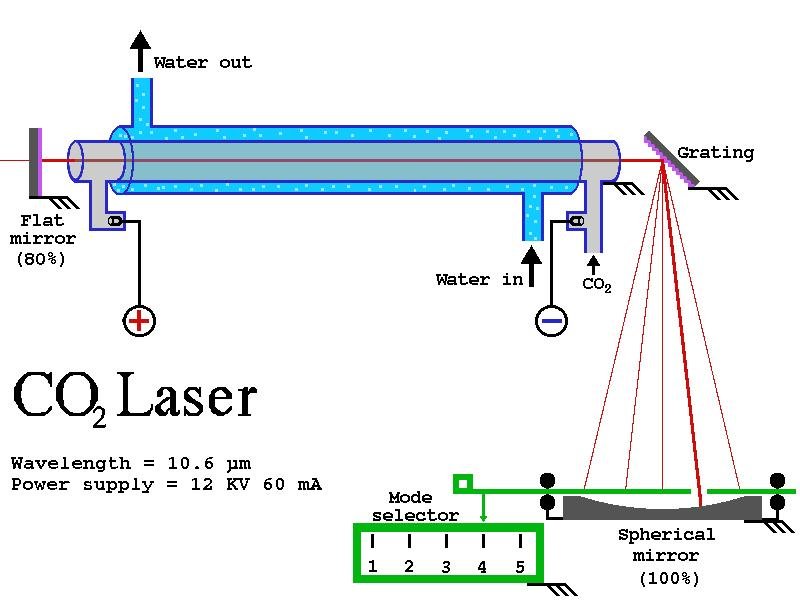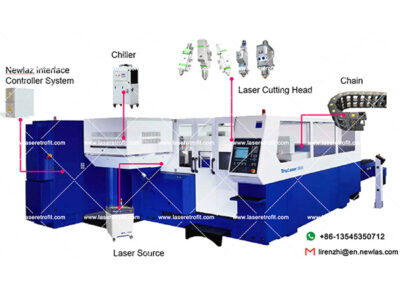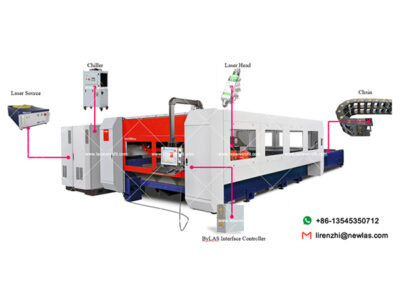Laser (light amplification by stimulated emission of radiation) beams are highly concentrated beams of light with high frequency. This results in a high-energy beam of light that can be focused on a small area. Whenever a laser beam is focused on a material, it rapidly heats the focused area, converting the light energy to heat energy. The heated material melts and blows away, resulting in a hole.
Laser cutting allows you to cut a wide variety of materials, ranging from a thin sheet of paper to even a thick metal plate using laser beams. However, different types of lasers can yield varying results on different materials.
Among the three main types of lasers that are available for laser cutting, the most widely used are fiber and CO2 lasers. The distinctive factor between these is the active gain medium used in them. The fiber laser uses a solid-state medium such as an optical fiber, whereas the CO2 laser uses CO2 gas.
In this article, we’ll go over the basics of the two types of lasers and discuss the differences between them. So, let’s get focused.
1. Components of a Laser

The main elements that are used to create a laser beam are the following:
- An energy source: Energy sources such as flashlamps, electrical discharges, and arc lights are used to provide energy (photons in the light) to the laser system.
- A gain medium (also active laser medium): A gain medium is the main differentiating factor among the various kinds of laser beams. In our case, a fiber laser uses a solid-state gain medium, and a CO2 laser uses a gas-state gain medium. This medium determines the different properties of the laser beams that are produced.
- An optical resonator: This is an arrangement of a highly reflective set of mirrors that further amplifies the laser beam. The light beam repeatedly bounces between the mirrors through the gain medium before it exits the system. This enables the laser to possess as much energy as possible before exiting the cavity.
Now we begin to understand the acronym “laser”. Light (radiation) from the source is stimulated in a medium, which is further amplified using an optical resonator. These are just the basics of how a laser system works, and there’s no need to scratch our heads around the minute details of the tech. For now, just understanding the basics will be enough to grasp the differences between fiber and CO2 lasers.
1.1 CO2 Lasers

The use of CO2 gas as a gain medium in the laser system characterizes CO2 lasers. A sealed gas tube with reflectors at both ends forms the backbone of any CO2-based laser machine. The tube is filled with a mixture of nitrogen, carbon dioxide, hydrogen, helium, and xenon gases. A high-voltage electrical discharge is passed through the tube, which starts a chain reaction in the gas mixture, creating a high-energy laser beam. However, in newer machines, even a radio frequency (RF) generator can be used as a power source.
A CO2 laser machine can convert around 10-20% of the electrical input power into usable optical power, giving it a higher efficiency rating than other gas lasers. It also has a wavelength between 9 and 11 μm, with most commercially available machines using a CO2 laser with a 10.6 μm wavelength. This enables the CO2 laser beam to be absorbed by most of the materials out there, ranging from plastics and wood to even some metals.
Since the CO2 laser was one of the earliest gas-based laser beams, many industries readily accepted its development. You can find CO2 machines ranging from 50-watt output power to as high as 4.5 kW. The output power of a CO2 machine is characterized by the size of the gas tube. Hence, the size of CO₂ machines can range from a desktop device to as huge as an SUV.
CO2 lasers are more common than you might think. A hobbyist-level K40 laser machine can produce a 40-W CO2 laser beam, which can be used for paper cutting designs, wood etching, decorative laminates, acrylics, and even something as fancy as neon lighting signs can be cut via a CO2 laser. CO2 laser beams are also being used in lidar technology for autonomous vehicles because the beams are nearly invisible.
1.2 Fiber Lasers

In contrast to the gas-based CO2 lasers, a fiber laser comprises a solid optical fiber (fiber-optic) cable as its gain medium. The fiber-optic cable is doped with rare earth metals like erbium, ytterbium, neodymium, dysprosium, praseodymium, thulium, and holmium. The energy source used for these lasers is a solid fiber-coupled laser diode, which provides light to the optical cable.
A fiber laser’s wavelength depends on the mixture of the rare earth elements with which it is doped. An ytterbium laser has a wavelength of 1.064 μm, which allows it to cut and etch various metals and even non-metals. Fiber lasers can also convert up to 35-50% of their electrical input to optical light. For example, a lower wattage 18-kW fiber laser could provide similar results to a high-powered 70-kW CO2 laser.
Depending upon the power of the fiber lasers, they can be used for a lot more than cutting materials. The US Navy developed a 33-kW fiber laser system to be used in defense applications. It was able to successfully take down an unmanned aerial vehicle as a part of its tests. In the medical industry, Lasik operations are usually carried out using a fiber laser beam. Drilling holes in concrete and spectroscopy are also some niche uses of fiber laser systems.
These applications provide a small glimpse of the wide range of the uses of fiber lasers. However, at the hobbyist level, there’s a stark difference between this laser system and CO2. Now that we’ve understood the basics of each, it becomes easier to grasp the differences between the two.
2. The Differences
Naturally, there are some significant differences between these two types of lasers. Here are some of the key distinctions.
2.1 Laser Source
The CO2 laser uses a flashlamp or an RF generator as its energy source and a gas mixture in a tube to generate and amplify the laser beams. The CO2 laser system is thus classified as a gas-based laser system. The larger the CO2 tube, the more powerful the laser beam.
A fiber laser uses an optical fiber doped in rare earth metals to amplify the laser beam. Because a solid strand of fiber is used to generate a high-energy laser beam, a fiber laser is classified as a solid-state laser. The intensity of the laser beam depends on the energy source, the doping process, and the length of the optical fiber.
2.2 Power Consumption
CO2 lasers can achieve a photoelectric conversion of around 10-15%. Thus, for a 50-W laser, you’d need to have a power source of at least 500 W. This translates to an overall increase in the operation cost for the machines. CO2 tubes need additional cooling equipment to cool down the tubes, which further increases the power consumption of the machines.
Fiber lasers can achieve a 35-50% power efficiency. So, a 50-W fiber laser system would need only a 100-150-W power supply. This drastically reduces the overall cost of operation and results in huge energy savings. Also, low-powered fiber laser machines can operate well with little to no additional cooling.
2.3 Wavelength

A CO2 laser has a wavelength of approximately 10 μm. This limits the materials it can work with, and highly reflective materials can’t be processed with CO2 lasers because they cannot absorb this wavelength of light and are therefore unaffected by it. Thus, shiny metals like aluminum, steel, copper, and brass can’t be readily cut using low-powered CO2 lasers.
Fiber laser has a much shorter wavelength at 1.04 μm, which allows it to penetrate through most of the materials; these can readily absorb this laser beam. Thus, a fiber laser can be used on a wide variety of materials.
2.4 Speeds
Overall, CO2 lasers have slower cutting speeds. Below 4 mm thickness, a similarly powered CO2 laser would be three times slower compared to a fiber laser. This is because of the wavelength characteristics and because of a wider focus area of the laser beam. The overall energy of the CO2 laser beam is spread over a larger area and the laser is also limited by the absorptivity of the material.
Fiber lasers, in contrast, have a much more focused laser beam as a result of their lower wavelengths. This allows for rapid heating of the material on the focus area and higher cutting speeds can be achieved. However, a noteworthy point is that beyond 8-mm thickness, both the lasers have similar cutting speeds.
Note that with regards to speed, we’re focusing only on the cutting characteristics and not including any machine kinematics. The speed of the machine itself will vary.
2.5. Construction
A CO2 laser system has to use a complex configuration of mirrors and lenses to transmit and focus the laser beam. It requires more maintenance, such as regularly cleaning the mirrors and chiller units. The CO2 tube is also relatively exposed to the external environment and can easily be affected by it.
As a fiber laser uses a flexible optical fiber strand at its core, it practically eliminates any need for mirrors to transmit the laser beams. A double cladding sheath can be used to protect the fiber from the external environment and it doesn’t require much looking after. Overall, the machine’s construction is simpler and relatively maintenance-free.
2.6 Cost & Life
The initial investment cost of the fiber laser systems can be quite high, from over $40,000 to even $1,000,000, depending on the power rating of the machine. However, considering the overall machining speeds, material varieties, and operating costs, the fiber laser system pays itself off in no time. Also, the life of the fiber laser power source is considerably higher, around 30,000+ hours. This is perhaps the main advantage of fiber laser systems.
The initial cost of CO2-based laser machines is very cheap compared to fiber lasers. You can get a basic hobbyist level CO2 machine for just about $2,000-$3,000, with really high-quality ones starting at around $10,000. However, considering a lower cutting speed, high energy requirements, and regular maintenance, the costs can quickly pile up. A CO2 laser tube, too, lasts only about 2,000 hours. This adds to the overall increase in operating costs of CO2 laser machines.
3. Conclusion
In summary, both CO2 and fiber lasers are on par with each other in terms of their machinability. While CO2 is a comparatively older technology, it still has its merits. CO2 lasers are readily available, initial costs are cheap, and they can be used with many materials, mainly non-metals, for etching, engraving, and cutting.
In contrast, fiber laser technology is an improvement over CO2 technology in certain aspects. It can easily etch metals, it has a tighter focus area, and it’s coupled with lower operating costs, after a higher upfront investment.






